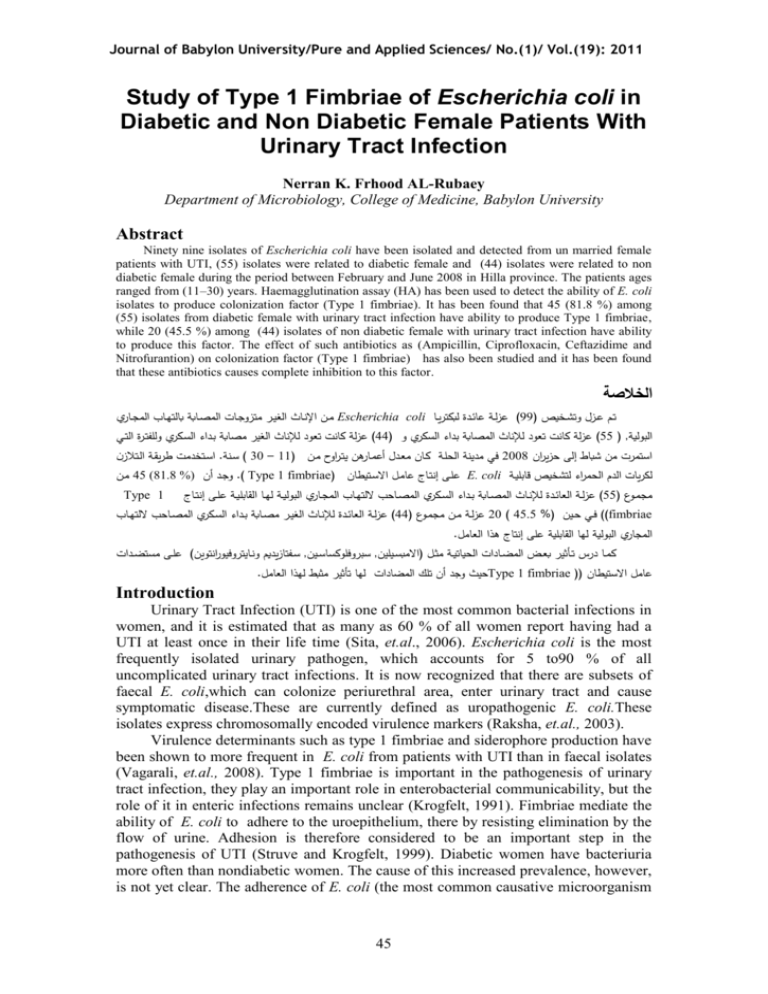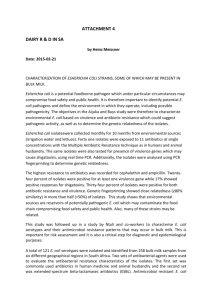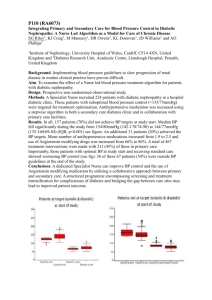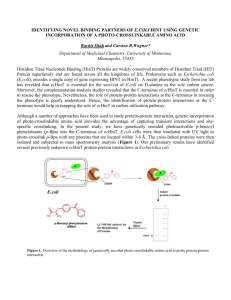Study Type 1 Fimbriae of Escherichia coli in Diabetic and Non
advertisement

Journal of Babylon University/Pure and Applied Sciences/ No.(1)/ Vol.(19): 2011 Study of Type 1 Fimbriae of Escherichia coli in Diabetic and Non Diabetic Female Patients With Urinary Tract Infection Nerran K. Frhood AL-Rubaey Department of Microbiology, College of Medicine, Babylon University Abstract Ninety nine isolates of Escherichia coli have been isolated and detected from un married female patients with UTI, (55) isolates were related to diabetic female and (44) isolates were related to non diabetic female during the period between February and June 2008 in Hilla province. The patients ages ranged from (11–30) years. Haemagglutination assay (HA) has been used to detect the ability of E. coli isolates to produce colonization factor (Type 1 fimbriae). It has been found that 45 (81.8 %) among (55) isolates from diabetic female with urinary tract infection have ability to produce Type 1 fimbriae, while 20 (45.5 %) among (44) isolates of non diabetic female with urinary tract infection have ability to produce this factor. The effect of such antibiotics as (Ampicillin, Ciprofloxacin, Ceftazidime and Nitrofurantion) on colonization factor (Type 1 fimbriae) has also been studied and it has been found that these antibiotics causes complete inhibition to this factor. الخالصة عممماعناثممد عنلغيم عمتوختممد عنلمصممديععيدلتبممدمعنلمتممد عEscherichia coli)ععزولممععزدةممبكعليات ممدعع99(ع تم عزمموتعختصم )عزولععادث عتعخبعلإلثد عنلغي عمصديععبمبنءعنلسما عخلترتم كعنلتم ع44()عزولععادث عتعخبعلإلثد عنلمصديععببنءعنلسا عخعع55ع(ع,نلبخل ع عنسمت بم عر ةمععنلمت واع.ع)عسمثع00ع–ع11(عف عمبيثععنلحتمعععامداعمعمبتعمزممد اعيتم نخ عمماععع8002عماعصيدطعإلىعحو ناع عمماع45 (81.8 %)عختمبعماعع.) Type 1 fimbriae( عزتمىعإثتمدععزدممالعنيسمت رداعععE. coliعقدبت مععع نستم لك د عنلب عنلحم نءعلتص Type 1 )عزولممععنلعدةممبكعلإلثممد عنلمصممديععبممبنءعنلسمما عنلمصممدحمعيلتبممدمعنلمتممد عنلبخل ممععلبممدعنلةدبت ممععزتممىعإثتممدعععع55(متمممخ ع )عزولممععنلعدةممبكعلإلثممد عنلغيم عمصممديععبممبنءعنلسمما عنلمصممدحمعيلتبممدمع44(عزولممععممماعمتمممخ ع80ع)ع4555ع%())عفم عحممياععfimbriae ع.نلمتد عنلبخل ععلبدعنلةدبت ععزتىعإثتدعع ذنعنلعدمال عسممرتدو ب عخثممديت خفيخ نثتخ ا)ععزتممىعمستاممبن ع,عسب خفتخاسدسمميا,عععععععععامممدعب تعتم بي عيعمماعنلماممدبن عنلح دت ممععمبممالع(نيميسمميتيا .حي عختبعماعتتكعنلمادبن ععلبدعت بي عمبيطعلبذنعنلعدمالType 1 fimbriae ((زدمالعنيست رداع Introduction Urinary Tract Infection (UTI) is one of the most common bacterial infections in women, and it is estimated that as many as 60 % of all women report having had a UTI at least once in their life time (Sita, et.al., 2006). Escherichia coli is the most frequently isolated urinary pathogen, which accounts for 5 to90 % of all uncomplicated urinary tract infections. It is now recognized that there are subsets of faecal E. coli,which can colonize periurethral area, enter urinary tract and cause symptomatic disease.These are currently defined as uropathogenic E. coli.These isolates express chromosomally encoded virulence markers (Raksha, et.al., 2003). Virulence determinants such as type 1 fimbriae and siderophore production have been shown to more frequent in E. coli from patients with UTI than in faecal isolates (Vagarali, et.al., 2008). Type 1 fimbriae is important in the pathogenesis of urinary tract infection, they play an important role in enterobacterial communicability, but the role of it in enteric infections remains unclear (Krogfelt, 1991). Fimbriae mediate the ability of E. coli to adhere to the uroepithelium, there by resisting elimination by the flow of urine. Adhesion is therefore considered to be an important step in the pathogenesis of UTI (Struve and Krogfelt, 1999). Diabetic women have bacteriuria more often than nondiabetic women. The cause of this increased prevalence, however, is not yet clear. The adherence of E. coli (the most common causative microorganism 45 in bacteriuria) to uroepithelial cells is the first step in the pathogenesis of UTIS (Geerlings, et.al., 2002). Several researchers have pointed out that no relationship between the ability of a female subject's cells to bind bacteria and her age, postmenopausal status, or the duration or presence of secondary diabetes complications(e.g., retinopathy, neuropathy and microalbuminuria) (Aly,et.al.,1991). On the other hand, subinhibitory concentration (sub-MICS) of various antibiotics are able to modify the molecular architecture of the external surface of bacteria and some bacterial functions, such as the ability to adhere to the host cells, the surface bacterial energy, motility etc., thus influencing bacterial virulence (Braga, 1994). Materials And Methods Specimens and Strains Ninety nine of E. coli strains were isolated from urine samples of unmarried female patients with or without diabetes who suffering from urinary tract infection, their ages ranged from (11- 30) years who admitted to hospital in Hilla province. Haemagglutination Assay (HA) Haemagglutination test was achieved according to method of (Vidya, et.al., 2005) to detect the ability of E. coli isolates to produce Type 1 fimbriae.The haemagglutination assay was done in the presence of an equal volume of different antibiotics. The antibiotics used are (Ampicillin, Ciprofloxacin, Ceftazidime and Nitrofurantion). The haemgglutination assay in the presence of antibiotics is done only to E. coli isolates which have the ability to produce type 1 fimbriae. Results Out of the total (99) isolates, (55) isolates were related to diabetic female with UTI and (44) isolates were related to non diabetic female with UTI. It was found that out of among 55 isolates from diabetic female with UTI, only 45 (81.8 %) isolates have the ability to produce type 1 fimbriae and among 44 isolates from non diabetic female with UTI, only 20 (45.5 %) have the ability to produce type 1 fimbriae (Table 1). Table (2) shows the effect of some antibiotics on the colonization factor (Type 1 fimbriae) haemgglutination assay in the presence of antibiotics is done only to E. coli isolates which have the ability to produce type 1 fimbriae from diabetic and non diabetic female with UTI. Table 1. Prevalence of Type 1 fimbriae of E. coli isolates from diabetic and non diabetic female with UTI Isolates No. Diabetic female with UTI Isolates No. 99 Agg E. coli isolates No. 55 Agg E.coli isolates No. % 45 Ampicillin (81.8 %) Ciprofloxacin 46 Non Diabetic female with UTI Isolates No. 44 Agg E.coli isolates No. % 20 Ceftazidime (45. 5 %) Nitrofurantion Journal of Babylon University/Pure and Applied Sciences/ No.(1)/ Vol.(19): 2011 without with without with without with without with Diabetic 45 + + + + female with UTI Non + + + + diabetic 20 female with UTI Table 2. Agglutination technique results in the presence and absence of some antibiotics Ampicillin : 2 mg / ml Nitrofurantion :2.5 mg /ml Ciprofloxacin :2.5 mg /ml Ceftazidime : 2 mg / ml Discussion In this study, type 1 fimbriae was investigated in 45 (81.8 %) isolates among 55 isolates from diabetic female with UTI, and 20 (45. 5 %) isolates among 44 isolates from non diabetic female with UTI (Table 1). These results showed that Type 1 fimbriated E.coli adhered to the uroepithelial cells from diabetic women with UTI more than from non diabetic women with UTI. Adhesion is considered to be the first step in the sequence of events leading to colonization, is an important determinant of virulence and subsequent infection, and the relationships between disease and the adherence of microorganisms to patients cells have been investigated before by other researchers (Darwazeh, et.al., 1990). This result agrees with the result obtained by (Johnson, 1991) who have indicated that the isolation rate of Egg E.coli for type 1 fimbriae is (86) and (59 %) isolated from diabetic and without diabetic women with UTI, respectively . Also, (Geerlings, et.al., 2002) have pointed that female with diabetes have bacteriuria more often than female without diabetes, so Escherichia coli which have type 1 fimbriae adhere more to the uroepithelial cells of diabetic female than to those of female without diabetes,that related to the various substances (e.g., albumin, glucose) are present in the urine of diabetic patients or by the difference in the uroepithelial cells, also the diabetic uroepithelial cells have a different glycosylation of the receptor on their cells, which results in a higher adhere capacity and these receptors for the type 1 fimbriae of E. coli are glycoproteins (uroplakins that line the bladder mucosa) (Wu, et.al., 1996). The effect of some antibiotics on the type 1 fimbriae has also been studied when the haemagglutination assay is carried out in the presence of an equal volume of some antibiotics. It was found that all these antibiotics used generally inhibit the bacterial adhesiveness (Table 2). These observation are compatible with the hypothesis that the adhesion of E.coli to eukaryotic cells is mediated by the bacterial proteinaceous adhesions and the synthesis of such membrane associated protein factors can be differentially inhibited by low concentration of antibiotics. Similar finding was also reported by (Vidya, et.al., 2005) who has pointed that sub inhibitors concentration of many antibiotics do not kill bacteria, they are able to interfere with some important aspects of bacterial cell function and these ability of antibiotics to interfere with many bacterial pathogenecity factor may be one of the main criteria for choosing one drug over another. 47 On the other hand (Shibl, 1995) stated that sub inhibitors concentration of antibiotics can exert their antiadhesive effects by inhibition of synthesis or expression of adhesions on the bacterial cell surface which leads to the formation of functionally aberrant adhesions or due to release of adhesions from the surface of bacterial cells, or modify bacterial shape in such away as to interfere with the ability of the microorganisms to approach receptors on animal cell surface. References Aly, F.Z; Blackwell, C.C. and Mackenzie, D.A.(1991) Chronic atrophic oral Candidiasis among patients with diabetes mellitus :role of secretor status. Epidemiol. Infect. 106 : 355-363. Braga, P.C. (1994). Effect of sub inhibitory concentrations of seven macrolides and four flouroquinolones on adhesion of Staphylococcus aureus to human mucosal cells. Chemother. J. 40 : 304-310. Darwazeh, A.M.; Lamey, P.J. ; Samaranayak, L.P. and MacFarlans, T.W. (1990). The relationship between colonization, secretor status and in vitro adhesion of Candida albicans to buccal epithelial cells from diabetic.J. Med. Microbiol. 33 : 43-49. Geerlings, S.E.; Meiland, R.; van Lith, E.C.; Brouwe, E.C. and Gaastra,W.(2002).Adherence of type1 fimbrial Escherichia coli to uroepithelial cells. Amr.Diabet.Associa.Inc.25 : 1405-1409. Johnson, J.R. (1991).Virulence factors in Escherichia coli urinary tract infection. Clin.Microbiol.Rev. 4 : 80-128. Krogfelt, K.A. (1991).Bacterial Adhesion genetics, biogenesis and role in pathogenesis of fimbrial adhesions of Escherichia coli.J. Rev.Infect. Dis. 13: 721735. Raksha, R.; Srinivasa, H. and Macaden, R.S. (2003) Occurrence and characterization of uropathogenic Escherichia coli in urinary tract infections. Indian J. Med. Microbiol. 21 : 102-107. Shibl, A.M. (1995). Effect of antibiotics on adherence of microorganisms to epithelial cell surfaces. Rev Infect Dis. 7 : 51-60 Sita.N ; van Merode, T.; Bartelds, A.I.M. and Stobberingh, E.E.(2006). Urinary Tract Infections in general practice patients : diagnostic tests versus bacteriological culture. Antimicrob. Chemother. J. 57 (5) : 955-958. Struve, C. and Krogfelt, K.A. (1999). In vivo detection of Escherichia coli type 1 fimbrial expression and phase variation during experimental urinary tract infection. J. Microbiol. 145 : 2683-2690. Vagarali,M.A.; Karudesai, S.G.; Patil,C.S. and Metgud, S.C. (2008) Haemagglutination and siderophore production as the urovirulence marker of uropathogenic Escherichia coli. Clini. Microbiol. J. 26 (1) : 68-70. Vidya, K.C.; Mallya, P.S. and Rao, P.S. (2005). Inhibition of bacterial adhesion by subinhibitory concentrations of antibiotics. Mol. Microbiol. 23 (2) : 102-105. Wu, X.R. ;Sun, T.T. and Medina, J.J. (1996).In vitro binding of type 1fimbriated Escherichia coli to uroplakins Ia and Ib : relation to urinary tract infections. Proc. Natl.Acad. Sci.U.S.A. 93 : 9630-9635. 48






